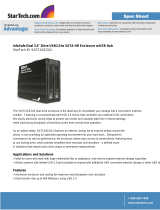
PowerEdge T110 II Technical Guide iv
7.1 Overview .................................................................................................. 25
7.2 DIMMs Supported ......................................................................................... 25
7.3 DIMM Slots ................................................................................................. 25
7.4 Speed ...................................................................................................... 25
7.5 Sparing ..................................................................................................... 25
7.6 Mirroring ................................................................................................... 25
7.7 RAID ........................................................................................................ 25
7.8 Supported Configurations ............................................................................... 25
8 Chipset ........................................................................................................ 27
8.1 Overview .................................................................................................. 27
8.2 Direct Media Interface .................................................................................. 27
8.3 PCI Express Interface .................................................................................... 27
8.4 SATA interface ............................................................................................ 27
8.5 AHCI ........................................................................................................ 27
8.6 PCI Interface .............................................................................................. 27
8.7 Low Pin Count (LPC) Interface ......................................................................... 27
8.8 Serial Peripheral Interface (SPI) ....................................................................... 28
8.9 Compatibility Module .................................................................................... 28
8.10 Advanced Programmable Interrupt Controller (APIC) ............................................... 28
8.11 USB interface ............................................................................................. 28
8.12 RTC ......................................................................................................... 28
8.13 GPIO ........................................................................................................ 29
8.14 Enhanced Power Management.......................................................................... 29
8.15 System Management Features .......................................................................... 29
8.15.1 TCO Timer ......................................................................................... 29
8.15.2 Processor Present Indicator ..................................................................... 29
8.15.3 Error Code Correction (ECC) Reporting ....................................................... 29
8.15.4 Function Disable .................................................................................. 29
8.16 System Management Bus (SMBus 2.0) ................................................................. 29
8.17 Intel Virtualization Technology for Directed I/O .................................................... 30
9 BIOS ............................................................................................................ 31
9.1 Overview .................................................................................................. 31
9.2 Supported ACPI States ................................................................................... 31
9.2.1 Power Management .............................................................................. 31
10 Embedded NICs/LAN on Motherboard (LOM) ........................................................... 33
10.1 Overview .................................................................................................. 33
10.2 NICs ........................................................................................................ 33
11 PCI Slots ...................................................................................................... 34
11.1 Overview .................................................................................................. 34
11.2 Quantities and Priorities ................................................................................ 34
11.3 PCI Card Dimensions ..................................................................................... 34
12 Storage ........................................................................................................ 35
12.1 Overview .................................................................................................. 35
12.2 Hard Drives ................................................................................................ 35
12.3 RAID Configurations ...................................................................................... 35
12.4 Storage Controllers ...................................................................................... 36
12.5 Optical Drives ............................................................................................. 37
12.6 Tape Drives ............................................................................................... 37
13 Video .......................................................................................................... 38
14 Rack Information ............................................................................................ 39
15 Operating Systems .......................................................................................... 40
16 Systems Management ...................................................................................... 41
16.1 Overview .................................................................................................. 41





















